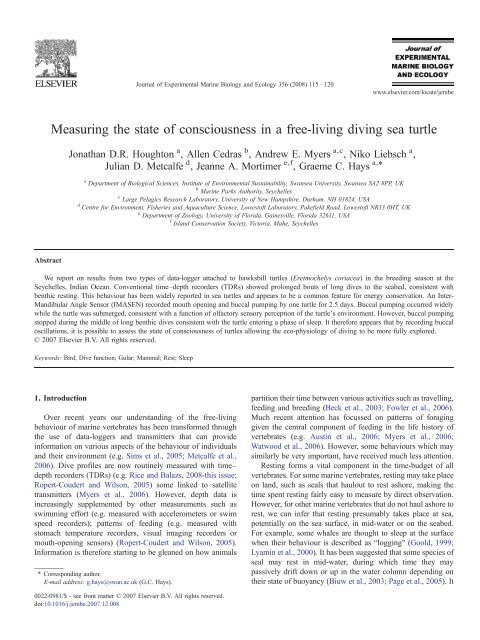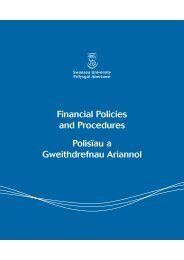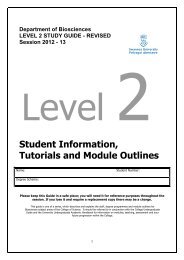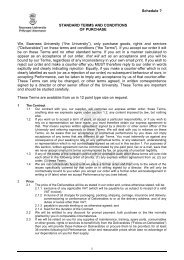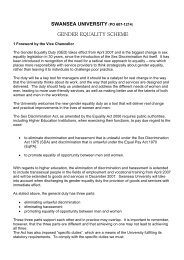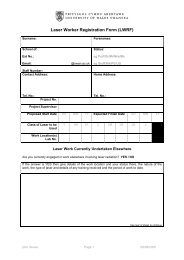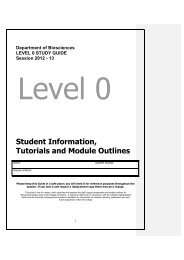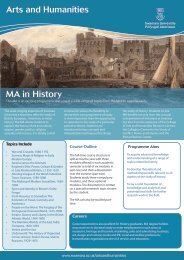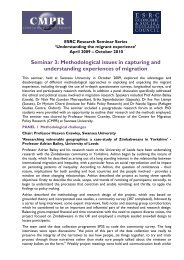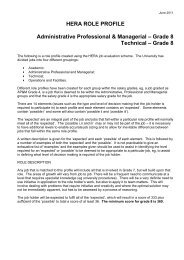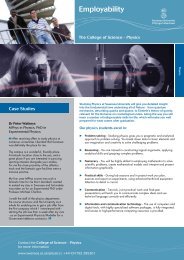Measuring the state of consciousness in a free-living diving sea turtle
Measuring the state of consciousness in a free-living diving sea turtle
Measuring the state of consciousness in a free-living diving sea turtle
Create successful ePaper yourself
Turn your PDF publications into a flip-book with our unique Google optimized e-Paper software.
Journal <strong>of</strong> Experimental Mar<strong>in</strong>e Biology and Ecology 356 (2008) 115–120<br />
www.elsevier.com/locate/jembe<br />
<strong>Measur<strong>in</strong>g</strong> <strong>the</strong> <strong>state</strong> <strong>of</strong> <strong>consciousness</strong> <strong>in</strong> a <strong>free</strong>-liv<strong>in</strong>g div<strong>in</strong>g <strong>sea</strong> <strong>turtle</strong><br />
Jonathan D.R. Houghton a , Allen Cedras b , Andrew E. Myers a,c , Niko Liebsch a ,<br />
Julian D. Metcalfe d , Jeanne A. Mortimer e,f , Graeme C. Hays a, ⁎<br />
a Department <strong>of</strong> Biological Sciences, Institute <strong>of</strong> Environmental Susta<strong>in</strong>ability, Swan<strong>sea</strong> University, Swan<strong>sea</strong> SA2 8PP, UK<br />
b Mar<strong>in</strong>e Parks Authority, Seychelles<br />
c Large Pelagics Re<strong>sea</strong>rch Laboratory, University <strong>of</strong> New Hampshire, Durham, NH 03824, USA<br />
d Centre for Environment, Fisheries and Aquaculture Science, Lowest<strong>of</strong>t Laboratory, Pakefield Road, Lowest<strong>of</strong>t NR33 0HT, UK<br />
e Department <strong>of</strong> Zoology, University <strong>of</strong> Florida, Ga<strong>in</strong>esville, Florida 32611, USA<br />
f Island Conservation Society, Victoria, Mahe, Seychelles<br />
Abstract<br />
We report on results from two types <strong>of</strong> data-logger attached to hawksbill <strong>turtle</strong>s (Eretmochelys coriacea) <strong>in</strong> <strong>the</strong> breed<strong>in</strong>g <strong>sea</strong>son at <strong>the</strong><br />
Seychelles, Indian Ocean. Conventional time–depth recorders (TDRs) showed prolonged bouts <strong>of</strong> long dives to <strong>the</strong> <strong>sea</strong>bed, consistent with<br />
benthic rest<strong>in</strong>g. This behaviour has been widely reported <strong>in</strong> <strong>sea</strong> <strong>turtle</strong>s and appears to be a common feature for energy conservation. An Inter-<br />
Mandibular Angle Sensor (IMASEN) recorded mouth open<strong>in</strong>g and buccal pump<strong>in</strong>g by one <strong>turtle</strong> for 2.5 days. Buccal pump<strong>in</strong>g occurred widely<br />
while <strong>the</strong> <strong>turtle</strong> was submerged, consistent with a function <strong>of</strong> olfactory sensory perception <strong>of</strong> <strong>the</strong> <strong>turtle</strong>'s environment. However, buccal pump<strong>in</strong>g<br />
stopped dur<strong>in</strong>g <strong>the</strong> middle <strong>of</strong> long benthic dives consistent with <strong>the</strong> <strong>turtle</strong> enter<strong>in</strong>g a phase <strong>of</strong> sleep. It <strong>the</strong>refore appears that by record<strong>in</strong>g buccal<br />
oscillations, it is possible to assess <strong>the</strong> <strong>state</strong> <strong>of</strong> <strong>consciousness</strong> <strong>of</strong> <strong>turtle</strong>s allow<strong>in</strong>g <strong>the</strong> eco-physiology <strong>of</strong> div<strong>in</strong>g to be more fully explored.<br />
© 2007 Elsevier B.V. All rights reserved.<br />
Keywords: Bird; Dive function; Gular; Mammal; Rest; Sleep<br />
1. Introduction<br />
Over recent years our understand<strong>in</strong>g <strong>of</strong> <strong>the</strong> <strong>free</strong>-liv<strong>in</strong>g<br />
behaviour <strong>of</strong> mar<strong>in</strong>e vertebrates has been transformed through<br />
<strong>the</strong> use <strong>of</strong> data-loggers and transmitters that can provide<br />
<strong>in</strong>formation on various aspects <strong>of</strong> <strong>the</strong> behaviour <strong>of</strong> <strong>in</strong>dividuals<br />
and <strong>the</strong>ir environment (e.g. Sims et al., 2005; Metcalfe et al.,<br />
2006). Dive pr<strong>of</strong>iles are now rout<strong>in</strong>ely measured with time–<br />
depth recorders (TDRs) (e.g. Rice and Balazs, 2008-this issue;<br />
Ropert-Coudert and Wilson, 2005) some l<strong>in</strong>ked to satellite<br />
transmitters (Myers et al., 2006). However, depth data is<br />
<strong>in</strong>creas<strong>in</strong>gly supplemented by o<strong>the</strong>r measurements such as<br />
swimm<strong>in</strong>g effort (e.g. measured with accelerometers or swim<br />
speed recorders); patterns <strong>of</strong> feed<strong>in</strong>g (e.g. measured with<br />
stomach temperature recorders, visual imag<strong>in</strong>g recorders or<br />
mouth-open<strong>in</strong>g sensors) (Ropert-Coudert and Wilson, 2005).<br />
Information is <strong>the</strong>refore start<strong>in</strong>g to be gleaned on how animals<br />
⁎ Correspond<strong>in</strong>g author.<br />
E-mail address: g.hays@swan.ac.uk (G.C. Hays).<br />
partition <strong>the</strong>ir time between various activities such as travell<strong>in</strong>g,<br />
feed<strong>in</strong>g and breed<strong>in</strong>g (Beck et al., 2003; Fowler et al., 2006).<br />
Much recent attention has focussed on patterns <strong>of</strong> forag<strong>in</strong>g<br />
given <strong>the</strong> central component <strong>of</strong> feed<strong>in</strong>g <strong>in</strong> <strong>the</strong> life history <strong>of</strong><br />
vertebrates (e.g. Aust<strong>in</strong> et al., 2006; Myers et al., 2006;<br />
Watwood et al., 2006). However, some behaviours which may<br />
similarly be very important, have received much less attention.<br />
Rest<strong>in</strong>g forms a vital component <strong>in</strong> <strong>the</strong> time-budget <strong>of</strong> all<br />
vertebrates. For some mar<strong>in</strong>e vertebrates, rest<strong>in</strong>g may take place<br />
on land, such as <strong>sea</strong>ls that haulout to rest ashore, mak<strong>in</strong>g <strong>the</strong><br />
time spent rest<strong>in</strong>g fairly easy to measure by direct observation.<br />
However, for o<strong>the</strong>r mar<strong>in</strong>e vertebrates that do not haul ashore to<br />
rest, we can <strong>in</strong>fer that rest<strong>in</strong>g presumably takes place at <strong>sea</strong>,<br />
potentially on <strong>the</strong> <strong>sea</strong> surface, <strong>in</strong> mid-water or on <strong>the</strong> <strong>sea</strong>bed.<br />
For example, some whales are thought to sleep at <strong>the</strong> surface<br />
when <strong>the</strong>ir behaviour is described as “logg<strong>in</strong>g” (Goold, 1999;<br />
Lyam<strong>in</strong> et al., 2000). It has been suggested that some species <strong>of</strong><br />
<strong>sea</strong>l may rest <strong>in</strong> mid-water, dur<strong>in</strong>g which time <strong>the</strong>y may<br />
passively drift down or up <strong>in</strong> <strong>the</strong> water column depend<strong>in</strong>g on<br />
<strong>the</strong>ir <strong>state</strong> <strong>of</strong> buoyancy (Biuw et al., 2003; Page et al., 2005). It<br />
0022-0981/$ - see front matter © 2007 Elsevier B.V. All rights reserved.<br />
doi:10.1016/j.jembe.2007.12.008
116 J.D.R. Houghton et al. / Journal <strong>of</strong> Experimental Mar<strong>in</strong>e Biology and Ecology 356 (2008) 115–120<br />
is thought that dolph<strong>in</strong>s may be able to sleep while cont<strong>in</strong>u<strong>in</strong>g to<br />
swim, sometimes keep<strong>in</strong>g one eye open beneath <strong>the</strong> surface<br />
(Lyam<strong>in</strong> et al., 2004; Sekiguchi et al., 2006). However, it is<br />
sometimes difficult to unequivocally resolve <strong>the</strong> function <strong>of</strong><br />
dives even when div<strong>in</strong>g animals are directly observed <strong>in</strong> aquaria<br />
(e.g. Lyam<strong>in</strong> et al., 2006). In such cases direct measurements <strong>of</strong><br />
an animal's <strong>state</strong>, for example from electroencephalogram<br />
read<strong>in</strong>gs, may be needed (Lyam<strong>in</strong> et al., 2004).<br />
Hard-shelled <strong>turtle</strong>s, both mar<strong>in</strong>e and freshwater species,<br />
appear to be unusual amongst air-breath<strong>in</strong>g divers <strong>in</strong> that <strong>the</strong>y<br />
typically rest on <strong>the</strong> bottom, <strong>of</strong>ten for extended periods, dur<strong>in</strong>g<br />
demersal stages <strong>of</strong> <strong>the</strong>ir life cycle. For example, dives to <strong>the</strong><br />
<strong>sea</strong>bed <strong>of</strong> N30 m<strong>in</strong> have regularly been recorded for green<br />
(Chelonia mydas)(Hays et al., 2004a), hawksbill (Eretmochelys<br />
imbricata) (van Dam and Diez, 1996; Storch et al., 2006) and<br />
loggerhead (Caretta caretta) <strong>turtle</strong>s (Houghton et al., 2002). In<br />
w<strong>in</strong>ter, when water temperatures are low, dives <strong>of</strong> over 6 h have<br />
been recorded for mar<strong>in</strong>e species, while freshwater <strong>turtle</strong>s may<br />
sometimes stay submerged for many weeks dur<strong>in</strong>g w<strong>in</strong>ter (see<br />
Hochscheid et al., 2005a and references <strong>the</strong>re<strong>in</strong>). For <strong>free</strong>-liv<strong>in</strong>g<br />
<strong>in</strong>dividuals, rest<strong>in</strong>g behaviour has generally been <strong>in</strong>ferred from<br />
exam<strong>in</strong>ation <strong>of</strong> dive pr<strong>of</strong>iles ra<strong>the</strong>r than be<strong>in</strong>g directly recorded.<br />
However, hard-shelled <strong>sea</strong> <strong>turtle</strong>s show characteristic behaviours<br />
when rest<strong>in</strong>g, which might be directly recorded allow<strong>in</strong>g<br />
<strong>the</strong>ir behavioural <strong>state</strong> to be unequivocally identified. Walker<br />
(1959) first noted that while submerged hard-shelled <strong>turtle</strong>s are<br />
awake, <strong>the</strong>y have <strong>the</strong>ir eyes open (<strong>in</strong> common with many o<strong>the</strong>r<br />
vertebrates) and also show cont<strong>in</strong>uous rhythmic throat movements<br />
termed buccal oscillations (sometimes called gular<br />
pump<strong>in</strong>g). Buccal oscillations generate a steady flow <strong>of</strong> water<br />
pass <strong>the</strong> chemosensory organs and, <strong>in</strong> essence, <strong>the</strong> behaviour<br />
corresponds with <strong>turtle</strong>s smell<strong>in</strong>g <strong>the</strong> water, presumably for<br />
detection <strong>of</strong> prey, predators, or o<strong>the</strong>r <strong>in</strong>dividuals (Manton et al.,<br />
1972a,b). Walker (1959) noted that when <strong>turtle</strong>s closed <strong>the</strong>ir<br />
eyes for extended periods (presumably sleep<strong>in</strong>g) buccal<br />
oscillations ceased. In essence, <strong>the</strong>refore, buccal oscillations<br />
seem to give an <strong>in</strong>dication <strong>of</strong> <strong>the</strong> <strong>state</strong> <strong>of</strong> <strong>consciousness</strong> for<br />
submerged hard-shelled <strong>turtle</strong>s. Recently, Hochscheid et al.<br />
(2005b) used a device termed <strong>the</strong> IMASEN (Inter-Mandibular<br />
Angle Sensor) to measure buccal oscillations <strong>in</strong> captive<br />
loggerhead <strong>turtle</strong>s. Buccal oscillations were associated with<br />
very small open<strong>in</strong>gs <strong>of</strong> <strong>the</strong> mouth (Hochscheid et al., 2005b). In<br />
l<strong>in</strong>e with <strong>the</strong> visual observations <strong>of</strong> Walker (1959), Hochscheid<br />
et al. (2005b) used an IMASEN to record <strong>the</strong> cessation <strong>of</strong> buccal<br />
oscillations when loggerhead <strong>turtle</strong>s rested on <strong>the</strong> bottom <strong>of</strong><br />
tanks with <strong>the</strong>ir eyes closed. Hochscheid et al. (2005b) suggested<br />
that IMASENs deployed on <strong>free</strong>-liv<strong>in</strong>g animals might be used to<br />
Table 1<br />
Details <strong>of</strong> successfully <strong>in</strong>strumented hawksbill <strong>turtle</strong>s<br />
Turtle<br />
id<br />
Equipment<br />
deployed<br />
Deployment<br />
date<br />
Length <strong>of</strong> dive<br />
record<br />
CCL<br />
(cm)<br />
2929 TDR 28/10/2004 16 days 80<br />
3089 TDR 30/10/2004 14 days 80<br />
2969 TDR+IMASEN 31/10/2004 15 days 80<br />
2872 TDR 2/11/2004 28 days 90<br />
TDR = time–depth recorder. CCL = curve carapace length (cm).<br />
Fig. 1. Typical IMASEN and depth traces from an active dive. Th<strong>in</strong> l<strong>in</strong>e = depth,<br />
thick l<strong>in</strong>e = Hall sensor read<strong>in</strong>gs. Part (a) shows <strong>the</strong> complete dive, part (b)<br />
shows 1 m<strong>in</strong> dur<strong>in</strong>g <strong>the</strong> dive. Note variation <strong>in</strong> depth <strong>in</strong>dicative <strong>of</strong> <strong>turtle</strong> activity,<br />
with <strong>the</strong> <strong>turtle</strong> ascend<strong>in</strong>g from about 10 m up to 6 m dur<strong>in</strong>g <strong>the</strong> dive. The values<br />
recorded by <strong>the</strong> IMASEN (mV) give a relative measure <strong>of</strong> mouth gape. When<br />
<strong>the</strong> mouth was closed <strong>the</strong> Hall sensor and magnet would be closer toge<strong>the</strong>r<br />
giv<strong>in</strong>g higher read<strong>in</strong>g (~1300 mV). When <strong>the</strong> mouth opened, <strong>the</strong> Hall sensor<br />
and magnet would become fur<strong>the</strong>r apart produc<strong>in</strong>g lower values. When at <strong>the</strong><br />
surface, wide mouth-open<strong>in</strong>g events were recorded. When submerged <strong>the</strong> trace<br />
shows regular small amplitude mouth-open<strong>in</strong>g events.<br />
record <strong>the</strong> <strong>state</strong> <strong>of</strong> <strong>consciousness</strong> <strong>of</strong> <strong>turtle</strong>s while on <strong>the</strong> <strong>sea</strong>bed.<br />
To explore this possibility, we deployed an IMASEN on a <strong>free</strong>liv<strong>in</strong>g<br />
hawksbill <strong>turtle</strong> <strong>in</strong> <strong>the</strong> <strong>in</strong>ternest<strong>in</strong>g <strong>in</strong>terval and recorded<br />
<strong>the</strong> extent <strong>of</strong> gular pump<strong>in</strong>g along with dive pr<strong>of</strong>iles.<br />
2. Materials and methods<br />
We attached an IMASEN (Driesen and Kern, Bad Bramsted,<br />
Germany) to a hawksbill <strong>turtle</strong> that had completed nest<strong>in</strong>g on<br />
Curieuse Island Mar<strong>in</strong>e National Park <strong>in</strong> <strong>the</strong> granitic Seychelles<br />
(4°16.827′ S; 55°44.462′ E). Close (with<strong>in</strong> 5 km) to <strong>the</strong> island<br />
are water depths up to 30 m. The IMASEN (5.5×3.4 cm, 27.6 g<br />
<strong>in</strong> air) consists <strong>of</strong> a Hall sensor, l<strong>in</strong>ked to a data-logger, which<br />
measures <strong>the</strong> proximity <strong>of</strong> a nearby magnet. By position<strong>in</strong>g <strong>the</strong><br />
Hall sensor on <strong>the</strong> upper mandible <strong>of</strong> <strong>the</strong> <strong>turtle</strong> and a<br />
neodymium boron magnet on <strong>the</strong> lower mandible, we recorded<br />
when <strong>the</strong> <strong>turtle</strong> opened its mouth (see Myers and Hays (2006)<br />
for a schematic <strong>of</strong> attachment). While <strong>the</strong> raw values (mV)<br />
recorded by <strong>the</strong> IMASEN gave a relative measure <strong>of</strong> mouth<br />
open<strong>in</strong>g, we were unable to convert <strong>the</strong>se values <strong>in</strong>to absolute<br />
gape distances (mm) because <strong>the</strong> <strong>turtle</strong> re-entered <strong>the</strong> water<br />
before we could complete validation measurements. The<br />
IMASEN sampled at 10 Hz and at this sampl<strong>in</strong>g frequency<br />
<strong>the</strong> logger memory was filled <strong>in</strong> 2.5 days.
J.D.R. Houghton et al. / Journal <strong>of</strong> Experimental Mar<strong>in</strong>e Biology and Ecology 356 (2008) 115–120<br />
117<br />
Table 2<br />
The number <strong>of</strong> U-dives and <strong>the</strong>ir depth and duration recorded for hawksbill<br />
<strong>turtle</strong>s <strong>in</strong> <strong>the</strong> Seychelles<br />
Turtle<br />
id<br />
U-dives<br />
Mean depth (m)<br />
(n, SD, maximum)<br />
Mean duration (m<strong>in</strong>)<br />
(n, SD, maximum)<br />
2929 4.5 (567, 2.2, 26.6) 28.2 (567, 8.7, 63.2) 69.2<br />
3089 9.1 (403, 3.5, 30.0) 31.3 (403, 8.3, 55.0) 61.9<br />
2969 11.6 (336, 1.8, 30.6) 49.2 (336, 9.6, 67.8) 77.5<br />
2872 19.9 (479, 1.1, 55.3) 45.7 (479, 14.9, 79.5) 52.9<br />
Percentage<br />
<strong>of</strong> time<br />
The Hall sensor and magnet were attached to <strong>the</strong> upper and<br />
lower jaws respectively with quick sett<strong>in</strong>g epoxy (Loctite “Super<br />
Glue”)(seeMyers and Hays, 2006) with <strong>the</strong> output lead runn<strong>in</strong>g<br />
to a data-logger attached to <strong>the</strong> head with a second type <strong>of</strong> quickset<br />
epoxy that also provided protection to <strong>the</strong> logger (David's<br />
Isopon P40). In addition a time–depth recorder (LTD 1200,<br />
LOTEK Mar<strong>in</strong>e Technologies, St. John's, Newfoundland) was<br />
attached to <strong>the</strong> carapace and recorded depth every 5 s. For a<br />
fur<strong>the</strong>r three <strong>turtle</strong>s we obta<strong>in</strong>ed dive records by attach<strong>in</strong>g only a<br />
TDR to <strong>the</strong> carapace (Table 1). Equipment was removed when<br />
<strong>turtle</strong>s returned to nest later that <strong>sea</strong>son. In three cases this<br />
corresponded with <strong>the</strong> subsequent nest<strong>in</strong>g event (<strong>in</strong>ternest<strong>in</strong>g<br />
<strong>in</strong>tervals 16, 14, 15 days respectively). In one case (<strong>turtle</strong> id 2872)<br />
<strong>the</strong> logger was retrieved after about one month. In this case <strong>the</strong><br />
TDR memory has filled up after 28 days. This <strong>turtle</strong> had nested<br />
unobserved after 15 days, as evidenced from <strong>the</strong> dive trace.<br />
We used bespoke data analysis s<strong>of</strong>tware (MultiTrace for<br />
W<strong>in</strong>dows, Jensen S<strong>of</strong>tware Systems, Laboe, Germany) to<br />
analyse <strong>the</strong> dive and IMASEN data. This s<strong>of</strong>tware allowed<br />
data visualisation and automated extraction <strong>of</strong> several parameters<br />
from each dive, <strong>in</strong>clud<strong>in</strong>g maximum depth and dive<br />
duration. We def<strong>in</strong>ed dives as those when a depth <strong>of</strong> ≥1 m was<br />
atta<strong>in</strong>ed. U-dives were identified by eye as those when <strong>the</strong>re<br />
was m<strong>in</strong>imal variation dur<strong>in</strong>g <strong>the</strong> bottom phase <strong>of</strong> dives (see<br />
Fig. 1). Dive data were corrected for sensor drift (only a few cm<br />
dur<strong>in</strong>g deployment) by “zero po<strong>in</strong>t calibration”. To do this we<br />
exam<strong>in</strong>ed <strong>the</strong> TDR data for <strong>the</strong> shallowest depth recorded every<br />
6 h, on <strong>the</strong> assumption that this would be <strong>the</strong> surface (0 cm). We<br />
quantified <strong>the</strong> frequency <strong>of</strong> mouth open<strong>in</strong>g dur<strong>in</strong>g dives us<strong>in</strong>g<br />
<strong>the</strong> ‘Count Events’ function <strong>of</strong> Multitrace, which measures how<br />
<strong>of</strong>ten <strong>the</strong> Hall sensor read<strong>in</strong>g crosses a threshold value over a<br />
selected period. This threshold value was selected <strong>in</strong> l<strong>in</strong>e with<br />
<strong>the</strong> amplitude <strong>of</strong> <strong>the</strong> signals received dur<strong>in</strong>g buccal oscillations.<br />
3. Results<br />
All <strong>the</strong> <strong>turtle</strong>s showed prolonged periods <strong>of</strong> U-dives to <strong>the</strong><br />
<strong>sea</strong> floor, dur<strong>in</strong>g which <strong>the</strong>re was very little variation <strong>in</strong> <strong>the</strong><br />
bottom phase. The typical depth <strong>of</strong> U-dives varied between 4<br />
and 20 m depend<strong>in</strong>g on <strong>the</strong> <strong>in</strong>dividual <strong>turtle</strong> and typical<br />
durations were 30–50 m<strong>in</strong> (Table 2).<br />
The IMASEN data revealed how a <strong>turtle</strong> opened its mouth<br />
for <strong>the</strong> 2.5 days after nest<strong>in</strong>g. Dur<strong>in</strong>g <strong>the</strong> first day after enter<strong>in</strong>g<br />
Fig. 2. Typical IMASEN and depth traces from a long U-dive to about 11 m.<br />
Th<strong>in</strong> l<strong>in</strong>e = depth, thick l<strong>in</strong>e = Hall sensor read<strong>in</strong>gs. Part (a) shows <strong>the</strong> complete<br />
dive, part (b) shows 1 m<strong>in</strong> dur<strong>in</strong>g <strong>the</strong> dive. Note that <strong>in</strong> contrast to Fig. 1 <strong>the</strong>re is<br />
little variation <strong>in</strong> depth dur<strong>in</strong>g <strong>the</strong> bottom phase, with <strong>the</strong> <strong>turtle</strong> rema<strong>in</strong><strong>in</strong>g at<br />
11 m. The values recorded by <strong>the</strong> IMASEN (mV) give a relative measure <strong>of</strong><br />
mouth gape. When submerged <strong>the</strong> trace shows very little mouth open<strong>in</strong>g.<br />
Fig. 3. IMASEN and depth traces from a long U-dive to around 11 m, where<br />
<strong>the</strong>re was <strong>in</strong>itially some variation <strong>in</strong> depth <strong>in</strong>dicative <strong>of</strong> activity. About 10 m<strong>in</strong><br />
<strong>in</strong>to <strong>the</strong> dive <strong>the</strong> variation <strong>in</strong> depth ceased and <strong>the</strong>re was an abrupt cessation <strong>of</strong><br />
rhythmic mouth open<strong>in</strong>gs. Part (a) shows <strong>the</strong> complete dive, part (b) shows<br />
1 m<strong>in</strong> dur<strong>in</strong>g <strong>the</strong> dive and highlights when rhythmic mouth open<strong>in</strong>gs ceased at<br />
about 22:42:10. The values recorded by <strong>the</strong> IMASEN (mV) give a relative<br />
measure <strong>of</strong> mouth gape.
118 J.D.R. Houghton et al. / Journal <strong>of</strong> Experimental Mar<strong>in</strong>e Biology and Ecology 356 (2008) 115–120<br />
There was some <strong>in</strong>dividual variation <strong>in</strong> <strong>the</strong> temporal patterns<br />
<strong>of</strong> dive duration over <strong>the</strong> <strong>in</strong>ternest<strong>in</strong>g <strong>in</strong>terval. However a<br />
consistent pattern for different <strong>in</strong>dividuals was that <strong>the</strong> shortest<br />
dives were always recorded <strong>in</strong> <strong>the</strong> 3 days preced<strong>in</strong>g <strong>the</strong><br />
subsequent nest<strong>in</strong>g event (Fig. 5). For example, for <strong>turtle</strong> 2969<br />
<strong>the</strong> mean daily dive duration <strong>in</strong>creased to around 50 m<strong>in</strong> by day<br />
12 <strong>of</strong> <strong>the</strong> <strong>in</strong>ternest<strong>in</strong>g <strong>in</strong>terval, but <strong>the</strong>n decreased to around<br />
10 m<strong>in</strong> <strong>in</strong> <strong>the</strong> 3 days preced<strong>in</strong>g <strong>the</strong> next nest<strong>in</strong>g event.<br />
4. Discussion<br />
Fig. 4. The mean rate <strong>of</strong> mouth open<strong>in</strong>g dur<strong>in</strong>g a dive, i.e. exclud<strong>in</strong>g time at <strong>the</strong><br />
surface, compared to dive duration. The longest dives were always associated<br />
with little mouth open<strong>in</strong>g.<br />
<strong>the</strong> water <strong>the</strong>re was a pattern <strong>of</strong> near-cont<strong>in</strong>uous mouth open<strong>in</strong>g<br />
associated with short dives (Fig. 1a). When <strong>the</strong> <strong>turtle</strong> was at <strong>the</strong><br />
surface <strong>the</strong>re were higher amplitude mouth-open<strong>in</strong>g events<br />
(Fig. 1a). Detailed exam<strong>in</strong>ation <strong>of</strong> <strong>the</strong>se periods <strong>of</strong> mouth<br />
open<strong>in</strong>g when <strong>the</strong> <strong>turtle</strong> was submerged showed that <strong>the</strong>y<br />
consisted <strong>of</strong> rhythmic open<strong>in</strong>g and clos<strong>in</strong>g (Fig. 1b). The <strong>turtle</strong><br />
soon started to conduct longer U-dives dur<strong>in</strong>g which <strong>the</strong>re were<br />
<strong>of</strong>ten long periods when <strong>the</strong> mouth rema<strong>in</strong>ed closed, with <strong>the</strong><br />
general exception <strong>of</strong> <strong>the</strong> start and end <strong>of</strong> <strong>the</strong> bottom phase <strong>of</strong><br />
<strong>the</strong>se dives (Fig. 2). Sometimes dur<strong>in</strong>g dives <strong>the</strong>re was a clearly<br />
demarked time when mouth open<strong>in</strong>g ceased (Fig. 3).<br />
The frequency <strong>of</strong> mouth open<strong>in</strong>g while <strong>the</strong> <strong>turtle</strong> was<br />
submerged was less on longer dives (Fig. 4). For example, for<br />
dives <strong>of</strong> N40 m<strong>in</strong> duration, <strong>the</strong> mean rate <strong>of</strong> mouth open<strong>in</strong>g<br />
while submerged was always b0.1 Hz, but this mean rate<br />
<strong>in</strong>creased to N0.5 Hz for some dives <strong>of</strong> b10 m<strong>in</strong>.<br />
The mouth-open<strong>in</strong>g events we recorded here for a <strong>free</strong>-liv<strong>in</strong>g<br />
hawksbill <strong>turtle</strong> are entirely consistent with <strong>the</strong> buccal<br />
oscillations recorded <strong>in</strong> submerged loggerhead <strong>turtle</strong>s <strong>in</strong><br />
captivity by Hochscheid et al. (2005b). These buccal oscillations<br />
are characterised by a lower amplitude than breath<strong>in</strong>g at<br />
<strong>the</strong> surface and are very regular, unlike mouth open<strong>in</strong>g<br />
associated with prey capture and <strong>in</strong>gestion. The frequency and<br />
relative amplitude <strong>of</strong> mouth-open<strong>in</strong>g events that we recorded<br />
were readily apparent, and our results show that measurements<br />
<strong>of</strong> buccal oscillations are now possible <strong>in</strong> <strong>the</strong> wild. It was clear<br />
that dur<strong>in</strong>g long U-dives <strong>the</strong>re was little mouth open<strong>in</strong>g. These<br />
observations support <strong>the</strong> contention (van Dam and Diez, 1996;<br />
Hays et al., 2004a) that long U-dives have a rest<strong>in</strong>g function for<br />
<strong>sea</strong> <strong>turtle</strong>s. Clearly we also measured o<strong>the</strong>r mouth-open<strong>in</strong>g<br />
movements (e.g. associated with breath<strong>in</strong>g at <strong>the</strong> surface). In<br />
o<strong>the</strong>r words a s<strong>in</strong>gle IMASEN can potentially measure several<br />
aspects <strong>of</strong> behaviour <strong>in</strong>clud<strong>in</strong>g buccal oscillations, breath<strong>in</strong>g<br />
and feed<strong>in</strong>g.<br />
There are several methods <strong>of</strong> record<strong>in</strong>g <strong>the</strong> activity <strong>of</strong> div<strong>in</strong>g<br />
animals. Simple TDRs record <strong>the</strong> extent <strong>of</strong> vertical movement,<br />
while flipper beat<strong>in</strong>g can be recorded <strong>in</strong> several ways to <strong>in</strong>dicate<br />
<strong>the</strong> extent <strong>of</strong> active swimm<strong>in</strong>g (e.g. Hays et al., 2004b; Hays<br />
et al., 2007; Wilson and Liebsch, 2003). However, sometimes<br />
Fig. 5. For four equipped hawksbill <strong>turtle</strong>s <strong>the</strong> proportion <strong>of</strong> time spent conduct<strong>in</strong>g U-dives dur<strong>in</strong>g <strong>the</strong> <strong>in</strong>ternest<strong>in</strong>g <strong>in</strong>terval. (a–d) Turtles 2929, 3089, 2969 and 2872<br />
respectively. Each <strong>in</strong>ternest<strong>in</strong>g <strong>in</strong>terval shown was recorded <strong>in</strong> its entirety.
J.D.R. Houghton et al. / Journal <strong>of</strong> Experimental Mar<strong>in</strong>e Biology and Ecology 356 (2008) 115–120<br />
119<br />
an animal may be at a s<strong>in</strong>gle depth, but still be active (e.g.<br />
dur<strong>in</strong>g benthic forag<strong>in</strong>g). In such cases activity may be revealed<br />
by a compass (e.g. Storch et al., 2006) or animal-borne cameras<br />
(e.g. Sem<strong>in</strong><strong>of</strong>f et al., 2006). However record<strong>in</strong>g whe<strong>the</strong>r a diver<br />
is awake or asleep is more problematic as <strong>in</strong>active animals may<br />
be <strong>in</strong> ei<strong>the</strong>r <strong>state</strong>. The standard method <strong>of</strong> record<strong>in</strong>g periods <strong>of</strong><br />
sleep <strong>in</strong> vertebrates is from electroencephalogram read<strong>in</strong>gs<br />
(Lyam<strong>in</strong> et al., 2004). This <strong>in</strong>volves plac<strong>in</strong>g external electrodes<br />
on <strong>the</strong> head. Such measurements have generally been conf<strong>in</strong>ed<br />
to captive animals. The use <strong>of</strong> IMASEN recorders provides an<br />
alternative method for objectively assess<strong>in</strong>g periods <strong>of</strong> sleep <strong>in</strong><br />
<strong>turtle</strong>s, extend<strong>in</strong>g <strong>the</strong> use <strong>of</strong> <strong>the</strong>se devices beyond that<br />
previously described for <strong>free</strong>-liv<strong>in</strong>g <strong>turtle</strong>s (Myers and Hays,<br />
2006, 2007). These devices <strong>the</strong>refore extend <strong>the</strong> behavioural<br />
data which can be derived from <strong>free</strong>-liv<strong>in</strong>g <strong>turtle</strong>s.<br />
Our IMASEN results for hawksbill <strong>turtle</strong>s are <strong>in</strong> contrast to<br />
those we have recently reported for lea<strong>the</strong>rback <strong>turtle</strong>s (Myers<br />
and Hays, 2006). In <strong>the</strong> <strong>in</strong>ternest<strong>in</strong>g period <strong>in</strong> <strong>the</strong> Caribbean,<br />
lea<strong>the</strong>rback <strong>turtle</strong>s range widely, mov<strong>in</strong>g up to several hundred<br />
km dur<strong>in</strong>g a s<strong>in</strong>gle <strong>in</strong>ternest<strong>in</strong>g <strong>in</strong>terval, and dive deeply,<br />
sometimes to several hundred metres (Georges et al., 2006;<br />
Myers and Hays, 2006). The diel pattern <strong>of</strong> <strong>the</strong>ir div<strong>in</strong>g is<br />
consistent with lea<strong>the</strong>rbacks track<strong>in</strong>g <strong>the</strong>ir prey located <strong>in</strong><br />
planktonic deep-scatter<strong>in</strong>g layers, with <strong>the</strong>se layers be<strong>in</strong>g found<br />
closer to <strong>the</strong> surface at night. IMASEN data suggest that<br />
lea<strong>the</strong>rback <strong>turtle</strong>s show buccal oscillations on <strong>the</strong> dive descent<br />
consistent with olfactory detection <strong>of</strong> prey (Myers and Hays,<br />
2006). Hence while IMASEN data have revealed how lea<strong>the</strong>rback<br />
<strong>turtle</strong>s <strong>sea</strong>rch for prey dur<strong>in</strong>g <strong>the</strong> <strong>in</strong>ternest<strong>in</strong>g period, <strong>the</strong>y<br />
reveal how hawksbill <strong>turtle</strong>s enter a rest<strong>in</strong>g <strong>state</strong> on <strong>the</strong> <strong>sea</strong>bed<br />
soon after nest<strong>in</strong>g.<br />
Interest<strong>in</strong>gly, even when <strong>the</strong>re was no regular mouth open<strong>in</strong>g<br />
dur<strong>in</strong>g <strong>the</strong> bottom phase <strong>of</strong> dives, <strong>the</strong> IMASEN data revealed<br />
that regular mouth open<strong>in</strong>g <strong>of</strong>ten resumed prior to <strong>the</strong> <strong>turtle</strong><br />
ascend<strong>in</strong>g to <strong>the</strong> surface. The implication is that sleep<strong>in</strong>g <strong>turtle</strong>s<br />
wake up some time before <strong>the</strong>y ascend at <strong>the</strong> end <strong>of</strong> <strong>the</strong> dive.<br />
Presumably this behaviour is associated with <strong>the</strong> <strong>turtle</strong> reestablish<strong>in</strong>g<br />
a <strong>state</strong> <strong>of</strong> awareness for its environment before it<br />
moves, giv<strong>in</strong>g it <strong>the</strong> time to detect potential predators or o<strong>the</strong>r<br />
hazards. This idea is consistent with evidence that predators play<br />
important roles <strong>in</strong> shap<strong>in</strong>g <strong>the</strong> behaviour <strong>of</strong> <strong>turtle</strong>s through all<br />
<strong>the</strong>ir life-history stages (Heithaus et al., 2007, 2008-this issue).<br />
Certa<strong>in</strong>ly for a range <strong>of</strong> div<strong>in</strong>g animals it has been suggested that<br />
<strong>the</strong> surface may be a risky place because <strong>the</strong> diver is silhouetted<br />
and so more visible to predators and also has fewer options for<br />
escape s<strong>in</strong>ce its potential escape directions are partly constra<strong>in</strong>ed<br />
by <strong>the</strong> surface (Heithaus and Frid, 2003). Hence it makes sense<br />
for a surfac<strong>in</strong>g <strong>turtle</strong> to make some <strong>in</strong>itial preparations before it<br />
ascends follow<strong>in</strong>g a period <strong>of</strong> sleep.<br />
For hard-shelled mar<strong>in</strong>e <strong>turtle</strong>s it appears that at many<br />
rookeries, rest<strong>in</strong>g dives form an important component <strong>of</strong> <strong>the</strong><br />
<strong>in</strong>ternest<strong>in</strong>g behaviour <strong>of</strong> female <strong>turtle</strong>s. While this is not<br />
universally true (see for example Hays et al., 2002), <strong>the</strong><br />
implication is that female hard-shelled <strong>turtle</strong>s <strong>of</strong>ten have a<br />
strategy <strong>of</strong> energy conservation dur<strong>in</strong>g <strong>the</strong> <strong>in</strong>ternest<strong>in</strong>g period<br />
which presumably allows <strong>the</strong>m to maximise <strong>the</strong>ir reproductive<br />
output. However, we recorded dist<strong>in</strong>ct patterns for <strong>the</strong> duration<br />
<strong>of</strong> dives dur<strong>in</strong>g <strong>the</strong> <strong>in</strong>ternest<strong>in</strong>g period. Generally, a few days<br />
before <strong>the</strong> subsequent nest<strong>in</strong>g event, <strong>the</strong> mean dive duration<br />
decreased. The implication is that <strong>turtle</strong>s were more active <strong>in</strong> <strong>the</strong><br />
days prior to nest<strong>in</strong>g. This pattern <strong>of</strong> <strong>in</strong>creas<strong>in</strong>g activity as a<br />
nest<strong>in</strong>g event approaches, has been <strong>in</strong>ferred several times before<br />
for <strong>sea</strong> <strong>turtle</strong>s. Hays et al. (1991) used <strong>the</strong> pattern <strong>of</strong> upl<strong>in</strong>ks<br />
from a satellite tag to <strong>in</strong>fer that an <strong>in</strong>ternest<strong>in</strong>g loggerhead <strong>turtle</strong><br />
<strong>in</strong> <strong>the</strong> Mediterranean spent longer at <strong>the</strong> surface as nest<strong>in</strong>g<br />
events approached. Similarly us<strong>in</strong>g limited data on dive<br />
duration relayed from satellite tags attached to green <strong>turtle</strong>s at<br />
Ascension Island, Hays et al. (1999) showed a decrease <strong>in</strong> dive<br />
duration as nest<strong>in</strong>g events approached, consistent with a<br />
reduction <strong>in</strong> <strong>the</strong> occurrence <strong>of</strong> U-dives. Our results for<br />
<strong>in</strong>ternest<strong>in</strong>g hawksbill <strong>turtle</strong>s extend <strong>the</strong>se previous observations<br />
with loggerhead and green <strong>turtle</strong>s and suggest that<br />
<strong>in</strong>creas<strong>in</strong>g activity towards <strong>the</strong> end <strong>of</strong> <strong>in</strong>ternest<strong>in</strong>g <strong>in</strong>tervals<br />
may occur widely <strong>in</strong> hard-shelled mar<strong>in</strong>e <strong>turtle</strong>s. Clearly it<br />
would be <strong>in</strong>terest<strong>in</strong>g to record <strong>the</strong> pattern <strong>of</strong> buccal oscillations<br />
throughout entire <strong>in</strong>ternest<strong>in</strong>g <strong>in</strong>tervals to more critically<br />
exam<strong>in</strong>e <strong>the</strong>se <strong>in</strong>ferences <strong>of</strong> patterns <strong>of</strong> activity. The reasons<br />
for this pattern <strong>of</strong> activity are uncerta<strong>in</strong>. However one<br />
possibility is that nest<strong>in</strong>g beach selection may be a protracted<br />
affair. Certa<strong>in</strong>ly <strong>the</strong> choice <strong>of</strong> nest<strong>in</strong>g beach may be a vital factor<br />
<strong>in</strong> driv<strong>in</strong>g <strong>the</strong> survival <strong>of</strong> eggs (Lee and Hays, 2004), with some<br />
beaches hav<strong>in</strong>g suboptimal conditions. Hence it might be<br />
expected that <strong>turtle</strong>s would spend some time select<strong>in</strong>g a suitable<br />
location and time for nest<strong>in</strong>g. Fur<strong>the</strong>rmore <strong>the</strong>re is strik<strong>in</strong>g<br />
evidence both from flipper tagg<strong>in</strong>g <strong>turtle</strong>s and molecular studies<br />
that female <strong>turtle</strong>s show degree <strong>of</strong> fidelity to particular nest<strong>in</strong>g<br />
beaches, which supports <strong>the</strong> suggestion <strong>of</strong> active selection <strong>of</strong> <strong>the</strong><br />
nest<strong>in</strong>g beach. However, <strong>the</strong> processes <strong>in</strong>volved <strong>in</strong> beach<br />
selection rema<strong>in</strong> unknown.<br />
In conclusion our results extend <strong>the</strong> utility <strong>of</strong> record<strong>in</strong>g<br />
mouth open<strong>in</strong>g <strong>in</strong> mar<strong>in</strong>e vertebrates. Such measurements can<br />
<strong>in</strong>form on breath<strong>in</strong>g rates at <strong>the</strong> surface, feed<strong>in</strong>g events while<br />
submerged and efforts to detect prey (Wilson et al., 2002; Myers<br />
and Hays, 2006) and also <strong>the</strong> <strong>state</strong> <strong>of</strong> <strong>consciousness</strong> <strong>of</strong> an<br />
animal (this study). Follow<strong>in</strong>g work with <strong>in</strong>ternest<strong>in</strong>g <strong>turtle</strong>s<br />
(this study and also Myers and Hays 2006) one key focus for<br />
fur<strong>the</strong>r work should be to make measurements <strong>of</strong> mouth<br />
open<strong>in</strong>g for <strong>turtle</strong>s on <strong>the</strong>ir forag<strong>in</strong>g grounds.<br />
Acknowledgements<br />
Fund<strong>in</strong>g was provided by a Natural Environment Re<strong>sea</strong>rch<br />
Council (UK) grant to GCH. AEM was supported by a NERC<br />
Studentship. [SS]<br />
References<br />
Aust<strong>in</strong>, D., Bowen, W.D., McMillan, J.I., Boness, D.J., 2006. Stomach<br />
temperature telemetry reveals temporal patterns <strong>of</strong> forag<strong>in</strong>g success <strong>in</strong> a <strong>free</strong>rang<strong>in</strong>g<br />
mar<strong>in</strong>e mammal. J. Anim. Ecol. 75, 408–420.<br />
Beck, C.A., Bowen, W.D., Millan, J.I.M., Iverson, S.J., 2003. Sex differences <strong>in</strong><br />
div<strong>in</strong>g at multiple temporal scales <strong>in</strong> a size-dimorphic capital breeder.<br />
J. Anim. Ecol. 72, 979–993.<br />
Biuw, M., McConnell, B., Bradshaw, C.J.A., Burton, H., Fedak, M., 2003.<br />
Blubber and buoyancy: monitor<strong>in</strong>g <strong>the</strong> body condition <strong>of</strong> <strong>free</strong>-rang<strong>in</strong>g <strong>sea</strong>ls<br />
us<strong>in</strong>g simple dive characteristics. J. Exp. Biol. 206, 3405–3423.
120 J.D.R. Houghton et al. / Journal <strong>of</strong> Experimental Mar<strong>in</strong>e Biology and Ecology 356 (2008) 115–120<br />
Fowler, S.L., Costa, D.P., Arnould, J.P.Y., Gales, N.J., Kuhn, C.E., 2006.<br />
Ontogeny <strong>of</strong> div<strong>in</strong>g behaviour <strong>in</strong> <strong>the</strong> Australian <strong>sea</strong> lion: trials <strong>of</strong><br />
adolescence <strong>in</strong> a late bloomer. J. Anim. Ecol. 75, 358–367.<br />
Georges, J.Y., Billes, A., Ferraroli, S., Fossette, S., Fretey, J., Grémillet, D.,<br />
Le Maho, Y., Myers, A.E., Tanaka, H., Hays, G.C., 2006. Meta-analysis<br />
<strong>of</strong> movements <strong>in</strong> Atlantic lea<strong>the</strong>rback <strong>turtle</strong>s dur<strong>in</strong>g nest<strong>in</strong>g <strong>sea</strong>son:<br />
conservation implications. Mar. Ecol. Prog. Ser. 338, 225–232.<br />
Goold, J.C., 1999. Behavioural and acoustic observations <strong>of</strong> sperm whales <strong>in</strong><br />
Scapa Flow, Orkney Islands. J. Mar. Biol. Assoc. U.K. 79, 541–550.<br />
Hays, G.C., Webb, P.I., Hayes, J.P., Priede, I.G., French, J., 1991. Satellite<br />
track<strong>in</strong>g <strong>of</strong> a loggerhead <strong>turtle</strong> (Caretta caretta) <strong>in</strong> <strong>the</strong> Mediterranean. J. Mar.<br />
Biol. Assoc. U.K. 71, 743–746.<br />
Hays, G.C., Luschi, P., Papi, F., del Seppia, C., Marsh, R., 1999. Changes <strong>in</strong><br />
behaviour dur<strong>in</strong>g <strong>the</strong> <strong>in</strong>ternest<strong>in</strong>g period and postnest<strong>in</strong>g migration for<br />
Ascension Island green <strong>turtle</strong>s. Mar. Ecol. Prog. Ser. 189, 263–273.<br />
Hays, G.C., Glen, F., Broderick, A.C., Godley, B.J., Metcalfe, J.D., 2002.<br />
Behavioural plasticity <strong>in</strong> a large mar<strong>in</strong>e herbivore: contrast<strong>in</strong>g patterns <strong>of</strong><br />
depth utilisation between two green <strong>turtle</strong> (Chelonia mydas) populations.<br />
Mar. Biol. 141, 985–990.<br />
Hays, G.C., Metcalfe, J.D., Walne, A.W., 2004a. The implications <strong>of</strong> lung<br />
regulated buoyancy control for dive depth and duration. Ecology 85,<br />
1137–1145.<br />
Hays, G.C., Metcalfe, J.D., Walne, A.W., Wilson, R.P., 2004b. First records <strong>of</strong><br />
flipper beat frequency dur<strong>in</strong>g <strong>sea</strong> <strong>turtle</strong> div<strong>in</strong>g. J. Exp. Mar. Biol. Ecol. 303,<br />
243–260.<br />
Hays, G.C., Marshall, G.J., Sem<strong>in</strong><strong>of</strong>f, J.A., 2007. Flipper beat frequency and<br />
amplitude changes <strong>in</strong> div<strong>in</strong>g green <strong>turtle</strong>s, Chelonia mydas. Mar. Biol. 150,<br />
1003–1009.<br />
Heithaus, M.R., Frid, A., 2003. Optimal div<strong>in</strong>g under <strong>the</strong> risk <strong>of</strong> predation.<br />
J. Theor. Biol. 223, 79–92.<br />
Heithaus, M.R., Frid, A., Wirs<strong>in</strong>g, A.J., Fourqurean, J.W., Burkholder, D.,<br />
Thomson, J., Befder, L., 2007. State-dependent risk-tak<strong>in</strong>g by green <strong>sea</strong><br />
<strong>turtle</strong>s mediates top-down effects <strong>of</strong> tiger shark <strong>in</strong>timidation <strong>in</strong> a mar<strong>in</strong>e<br />
ecosystem. J. Anim. Ecol. 76, 837–844.<br />
Heithaus, M.R., Wirs<strong>in</strong>g, A.J., Thomson, J.A., Burkholder, D.A., 2008. A review<br />
<strong>of</strong> lethal and non-lethal effects <strong>of</strong> predators on adult mar<strong>in</strong>e <strong>turtle</strong>s. J. Exp.<br />
Mar. Biol. Ecol. 356, 43–51 (this issue).<br />
Hochscheid, S., Bentivegna, F., Hays, G.C., 2005a. First records <strong>of</strong> dive<br />
durations <strong>in</strong> a hibernat<strong>in</strong>g <strong>sea</strong> <strong>turtle</strong>. Biol. Lett. 1, 83–87.<br />
Hochscheid, S., Maffuccia, F., Bentivegna, F., Wilson, R.P., 2005b. Gulps,<br />
wheezes, and sniffs: how measurement <strong>of</strong> beak movement <strong>in</strong> <strong>sea</strong> <strong>turtle</strong>s can<br />
elucidate <strong>the</strong>ir behaviour and ecology. J. Exp. Mar. Biol. Ecol. 316, 45–53.<br />
Houghton, J.D.R., Broderick, A.C., Godley, B.J., Metcalfe, J.D., Hays, G.C.,<br />
2002. Div<strong>in</strong>g behaviour dur<strong>in</strong>g <strong>the</strong> <strong>in</strong>ternest<strong>in</strong>g <strong>in</strong>terval for loggerhead<br />
<strong>turtle</strong>s (Caretta caretta) nest<strong>in</strong>g <strong>in</strong> Cyprus. Mar. Ecol. Prog. Ser. 227, 63–70.<br />
Lee, P.L.M., Hays, G.C., 2004. Polyandry <strong>in</strong> a mar<strong>in</strong>e <strong>turtle</strong>: females make <strong>the</strong><br />
best <strong>of</strong> a bad job. Proc. Natl. Acad. Sci. U. S. A. 101, 6530–6535.<br />
Lyam<strong>in</strong>, O.I., Manger, P.R., Mukhametov, L.M., Siegel, J.M., Shpak, O.V.,<br />
2000. Rest and activity <strong>state</strong>s <strong>in</strong> a gray whale. J. Sleep Res. 9, 261–267.<br />
Lyam<strong>in</strong>, O.I., Mukhametov, L.M., Siegel, J.M., 2004. Relationship between<br />
sleep and eye <strong>state</strong> <strong>in</strong> cetaceans and p<strong>in</strong>nipeds. Arch. Ital. Biol. 142,<br />
557–568.<br />
Lyam<strong>in</strong>, O.I., Pryaslova, J., Lance, V., Siegel, J.M., 2006. Sleep behaviour —<br />
reply. Nature 441, E11. doi:10.1038/nature04900.<br />
Manton, M., Karr, A., Ehrenfield, D., 1972a. Chemoreception <strong>in</strong> <strong>the</strong> migratory<br />
<strong>sea</strong> <strong>turtle</strong>, Chelonia mydas. Biol. Bull. (Woods Hole) 143, 184.<br />
Manton, M., Karr, A., Ehrenfield, D., 1972b. An operant method for <strong>the</strong> study <strong>of</strong><br />
chemoreception <strong>in</strong> <strong>the</strong> green <strong>turtle</strong>, Chelonia mydas. Bra<strong>in</strong> Behav. Evol, 5,<br />
188–201.<br />
Metcalfe, J.D., Hunter, E., Buckley, A.A., 2006. The migratory behaviour <strong>of</strong><br />
North Sea plaice: currents, clocks and clues. Mar. Freshw. Behav. Physiol.<br />
39, 25–36.<br />
Myers, A.E., Lovell, P., Hays, G.C., 2006. Tools for study<strong>in</strong>g animal behaviour:<br />
validation <strong>of</strong> dive pr<strong>of</strong>iles relayed via <strong>the</strong> Argos satellite system. Anim.<br />
Behav. 71, 989–993.<br />
Myers, A.E., Hays, G.C., 2006. Do lea<strong>the</strong>rback <strong>turtle</strong>s (Dermochelys coriacea)<br />
forage dur<strong>in</strong>g <strong>the</strong> breed<strong>in</strong>g <strong>sea</strong>son? A comb<strong>in</strong>ation <strong>of</strong> novel and traditional<br />
data logg<strong>in</strong>g devices provide new <strong>in</strong>sights. Mar. Ecol. Prog. Ser. 322,<br />
259–267.<br />
Myers, A.E., Hays, G.C., 2007. A novel technique for measur<strong>in</strong>g heart rate <strong>in</strong> a<br />
<strong>free</strong> swimm<strong>in</strong>g mar<strong>in</strong>e vertebrate. J. Exp. Mar. Biol. Ecol. 349, 44–51.<br />
Page, B., McKenzie, J., H<strong>in</strong>dell, M.A., Goldsworthy, S.D., 2005. Drift dives by<br />
male New Zealand fur <strong>sea</strong>ls (Arctocephalus forsteri). Can. J. Zool. 83,<br />
293–300.<br />
Rice, M.R., Balazs, G.H., 2008. Div<strong>in</strong>g behavior <strong>of</strong> <strong>the</strong> Hawaiian green <strong>turtle</strong><br />
(Chelonia mydas) dur<strong>in</strong>g oceanic migrations. J. Exp. Mar. Biol. Ecol. 356,<br />
121–127 (this issue).<br />
Ropert-Coudert, Y., Wilson, R.P., 2005. Trends and perspectives <strong>in</strong> animalattached<br />
remote sens<strong>in</strong>g. Front. Ecol. Environ. 3, 437–444.<br />
Sekiguchi, Y., Arai, K., Kohshima, S., 2006. Sleep <strong>in</strong> cont<strong>in</strong>uously active<br />
dolph<strong>in</strong>s. Nature 441, E9–E10. doi:10.1038/nature04898.<br />
Sem<strong>in</strong><strong>of</strong>f, J.A., Jones, T.T., Marshall, G.J., 2006. Underwater behaviour <strong>of</strong> green<br />
<strong>turtle</strong>s monitored with video-time–depth recorders: what's miss<strong>in</strong>g from<br />
dive pr<strong>of</strong>iles? Mar. Ecol. Prog. Ser. 322, 269–280.<br />
Sims, D.W., Southall, E.J., Tarl<strong>in</strong>g, G.A., Metcalfe, J.D., 2005. Habitat-specific<br />
normal and reverse diel vertical migration <strong>in</strong> <strong>the</strong> plankton-feed<strong>in</strong>g bask<strong>in</strong>g<br />
shark. J. Anim. Ecol. 74, 755–761.<br />
Storch, S., Hays, G.C., Hillis-Starr, Z., Wilson, R.P., 2006. Hurricane effects on<br />
div<strong>in</strong>g behaviour <strong>of</strong> a hawksbill <strong>turtle</strong>. Mar. Freshw. Behav. Physiol. 39,<br />
307–313.<br />
van Dam, R.P., Diez, C.E., 1996. Div<strong>in</strong>g behavior <strong>of</strong> immature hawksbills<br />
(Eretmochelys imbricata) <strong>in</strong> a Caribbean cliff-wall habitat. Mar. Biol. 127,<br />
171–178.<br />
Walker, W.F., 1959. Closure <strong>of</strong> nostrils <strong>in</strong> <strong>the</strong> Atlantic loggerhead and o<strong>the</strong>r <strong>sea</strong><br />
<strong>turtle</strong>s. Copeia 1959, 257–259.<br />
Watwood, S.L., Miller, P.J.O., Johnson, M., Madsen, P.T., Tyack, P.L., 2006.<br />
Deep-div<strong>in</strong>g forag<strong>in</strong>g behaviour <strong>of</strong> sperm whales (Physeter macrocephalus).<br />
J. Anim. Ecol. 75, 814–825.<br />
Wilson, R.P., Ste<strong>in</strong>furth, A., Ropert-Coudert, Y., Kato, A., Kurita, M., 2002.<br />
Lip-read<strong>in</strong>g <strong>in</strong> remote subjects: an attempt to quantify and separate<br />
<strong>in</strong>gestion, breath<strong>in</strong>g and vocalisation <strong>in</strong> <strong>free</strong>-liv<strong>in</strong>g animals us<strong>in</strong>g pengu<strong>in</strong>s<br />
as a model. Mar. Biol. 140, 17–27.<br />
Wilson, R.P., Liebsch, N., 2003. Up-beat motion <strong>in</strong> sw<strong>in</strong>g<strong>in</strong>g limbs; new<br />
<strong>in</strong>sights <strong>in</strong>to assess<strong>in</strong>g movement <strong>in</strong> <strong>free</strong>-liv<strong>in</strong>g aquatic vertebrates.<br />
Mar. Biol. 142, 537–547.


